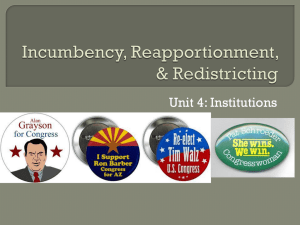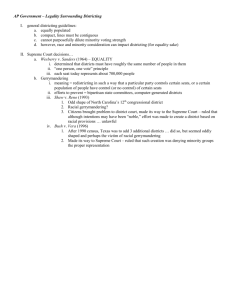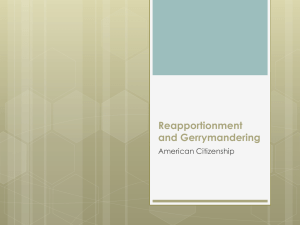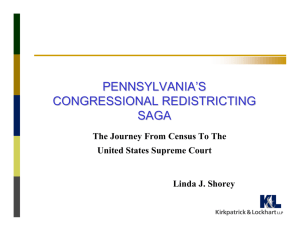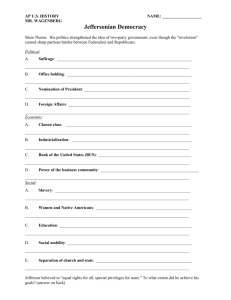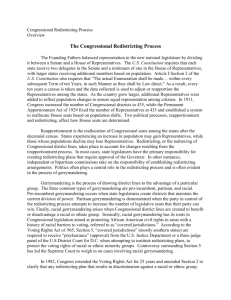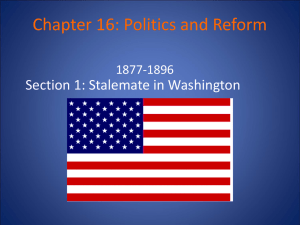Gerrymander In The Docket - Franklin & Marshall College
advertisement
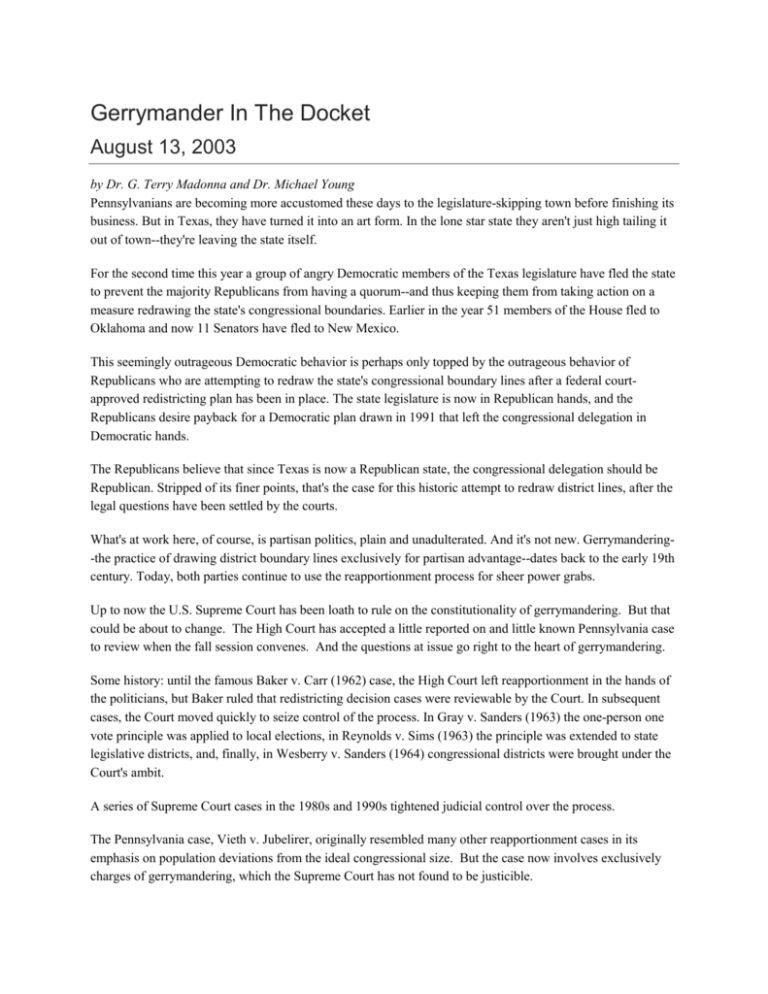
Gerrymander In The Docket August 13, 2003 by Dr. G. Terry Madonna and Dr. Michael Young Pennsylvanians are becoming more accustomed these days to the legislature-skipping town before finishing its business. But in Texas, they have turned it into an art form. In the lone star state they aren't just high tailing it out of town--they're leaving the state itself. For the second time this year a group of angry Democratic members of the Texas legislature have fled the state to prevent the majority Republicans from having a quorum--and thus keeping them from taking action on a measure redrawing the state's congressional boundaries. Earlier in the year 51 members of the House fled to Oklahoma and now 11 Senators have fled to New Mexico. This seemingly outrageous Democratic behavior is perhaps only topped by the outrageous behavior of Republicans who are attempting to redraw the state's congressional boundary lines after a federal courtapproved redistricting plan has been in place. The state legislature is now in Republican hands, and the Republicans desire payback for a Democratic plan drawn in 1991 that left the congressional delegation in Democratic hands. The Republicans believe that since Texas is now a Republican state, the congressional delegation should be Republican. Stripped of its finer points, that's the case for this historic attempt to redraw district lines, after the legal questions have been settled by the courts. What's at work here, of course, is partisan politics, plain and unadulterated. And it's not new. Gerrymandering-the practice of drawing district boundary lines exclusively for partisan advantage--dates back to the early 19th century. Today, both parties continue to use the reapportionment process for sheer power grabs. Up to now the U.S. Supreme Court has been loath to rule on the constitutionality of gerrymandering. But that could be about to change. The High Court has accepted a little reported on and little known Pennsylvania case to review when the fall session convenes. And the questions at issue go right to the heart of gerrymandering. Some history: until the famous Baker v. Carr (1962) case, the High Court left reapportionment in the hands of the politicians, but Baker ruled that redistricting decision cases were reviewable by the Court. In subsequent cases, the Court moved quickly to seize control of the process. In Gray v. Sanders (1963) the one-person one vote principle was applied to local elections, in Reynolds v. Sims (1963) the principle was extended to state legislative districts, and, finally, in Wesberry v. Sanders (1964) congressional districts were brought under the Court's ambit. A series of Supreme Court cases in the 1980s and 1990s tightened judicial control over the process. The Pennsylvania case, Vieth v. Jubelirer, originally resembled many other reapportionment cases in its emphasis on population deviations from the ideal congressional size. But the case now involves exclusively charges of gerrymandering, which the Supreme Court has not found to be justicible. There really is no question that gerrymandering occurred in the Pennsylvania case. Going into the redistricting process in 2001, there were 12 Republicans and 11 Democrats in the state's congressional delegation. Then the Republican legislature drew boundary lines more favorable to the Republicans--essentially by merging districts in a manner to force six Democrats to run against each other. The plan was appealed to a federal district court in Pennsylvania and the court overturned the plan, the first state plan ever to be reversed. The three-judge court majority said the populations in some of the districts were not close enough to satisfy the equal protection principle, despite the fact that the largest deviation was a mere 19 people from the 646,371 ideal for a district. Because the primary elections were imminent, the court allowed the unconstitutional plan to be used for the 2002 elections, and ordered the legislature to submit a new plan for 2004. The district court's majority delivered a stern lecture on the partisan nature of the Republican plan, which the court went to some length to emphasize in its opinion. In the decision, the court forecast that the Republicans would reduce considerably the number of Democratic congresspersons--a prescient view as it turned out. As a result of the 2002 elections, the Democrats have four fewer seats in the state's congressional delegation. Earlier this year, the legislature sent the district court a new plan that did little more than reduce the population deviations to zero in 15 districts and one person in four other districts. The plan was again drafted by Republicans for Republicans, and Democrats in the legislature were, as before, cut out of the process. It was classic gerrymandering. This time the district court approved the plan, but Democrats appealed to the U.S. Supreme Court, which to everyone's surprise agreed to hear the case. And here is where the plot thickens. The appeal to the Supreme Court is not based fundamentally on the well-established "one-person one vote" principle, but on the much dicer question whether gerrymandering may be unconstitutional. There are three specific questions before the Supreme Court that go to the constitutionality of gerrymandering. Any of them, if accepted by the Supreme Court, could end gerrymandering, as we know it. The first argues that the district court was mistaken when it said that a political party may never claim that partisan gerrymandering is unconstitutional. A second argument is that the state violates the Equal Protection Clause when it makes all other neutral aspects of redistricting subordinate to achieving partisan advantage. And the third argues that the state violates Article 1 of the federal constitution when boundary lines are drawn in such a way that one party will capture a supermajority of the state's congressional districts, even though that party's candidates win less than half of the popular statewide vote. No one really knows what the Supremes will do with these questions. Maybe they have taken the case to reassert their centuries old practice of viewing reapportionment, per se, as a political process. Or maybe they will issue a narrow technical ruling on one of the finer points in the appeal. Either of these outcomes would mean business as usual. But maybe what's a-foot-here is a fundamental reevaluation by the Supreme Court of the role of partisan politics in the reapportionment process. Maybe the Court is ready to say that since both political parties have misused reapportionment in so many egregious ways, the time has come to end the political gerrymander. If so, the Pennsylvania case will become enshrined with earlier landmark cases, such as like Baker v. Carr and Reynolds v. Sims, which fundamentally altered the nature of redistricting. Gerrymandering did not begin in Pennsylvania--but it well could end here. -----------------Politically Uncorrected™ is published twice monthly. Dr. G. Terry Madonna is a Professor of Public Affairs at Franklin & Marshall College, and Dr. Michael Young is a former Professor of Politics and Public Affairs at Penn State University and Managing Partner at Michael Young Strategic Research. The opinions expressed in this article are solely those of the authors and do not necessarily reflect the opinions of any institution or organization with which they are affiliated. This article may be used in whole or part only with appropriate attribution. Copyright © 2003 Terry Madonna and Michael Young.

